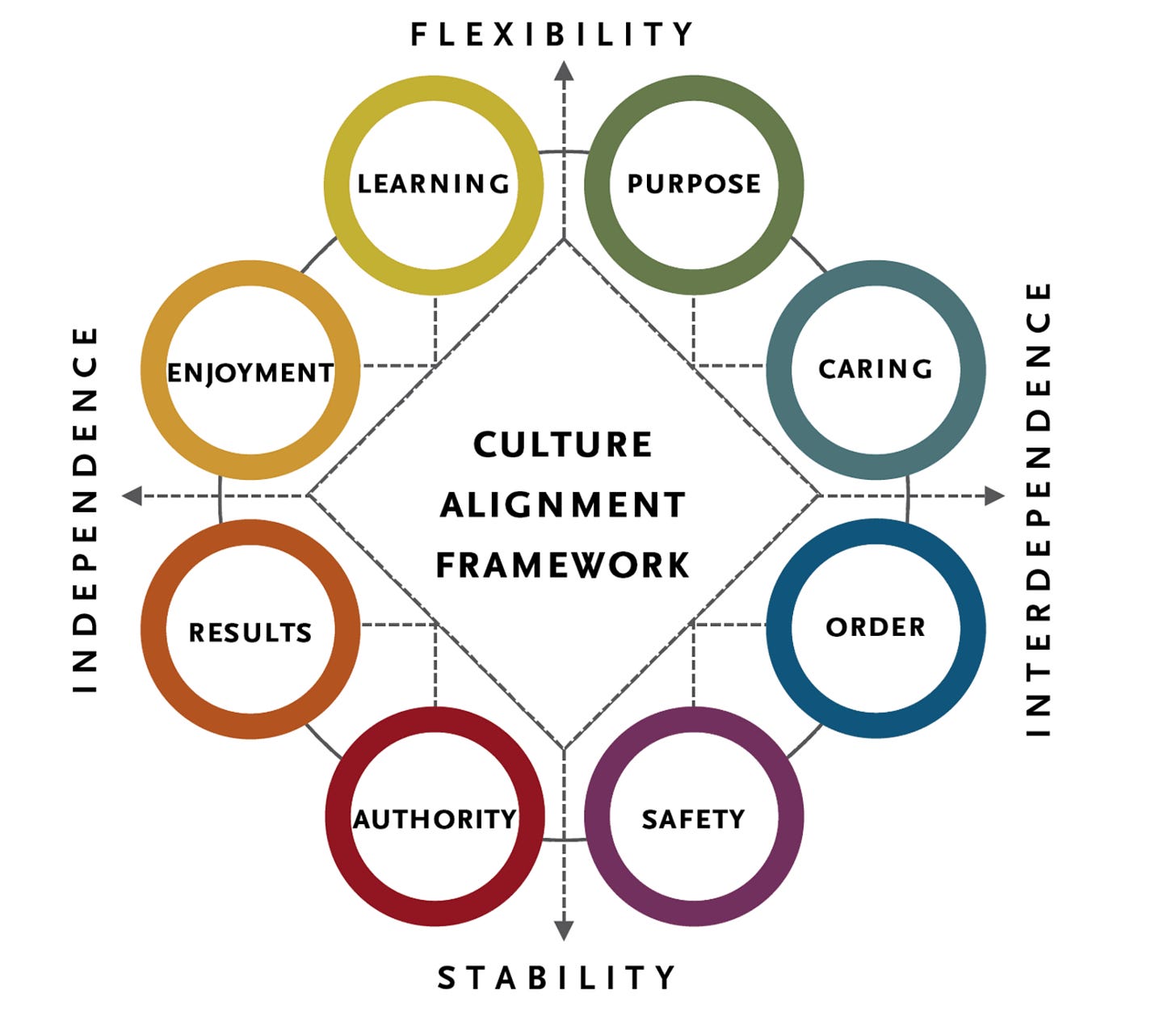The True Playbook of Culture: How Leaders Can Effectively Shape Organizations
This article examines how culture influences performance, why ignoring it can be detrimental, and how genuine leaders drive change by recognizing and responding to eight distinct cultural styles.
1. Culture is a Management Lever. Most Leaders Ignore It.
Culture shapes attitudes, behavior, and performance just as powerfully as strategy—but it is often misunderstood or relegated to HR. Strategy outlines the actions to take, while culture influences how individuals behave during the execution of those actions. "Culture eats strategy for breakfast" is more than just a quote. It is a warning. Schein (2010) underlined that culture operates at unconscious levels and is often more enduring than strategic plans.
2. Four Defining Attributes of Culture
Built on decades of research, culture has these fundamental properties:
Shared – Exists only at group level.
Pervasive – Visible in behaviors, rituals, systems.
Enduring – Shaped by attraction–selection–attrition cycles (Schneider, 1987).
Implicit – People sense and follow it instinctively (Schwartz, 1992; Wilson, 1998).
Understanding these fundamental properties would enable you to adjust your systems from a macro to a micro level.
3. The Two Axes of Culture
Culture varies along two universal dimensions:
People Interaction: Independence ↔ Interdependence
Response to Change: Stability ↔ Flexibility
Adapted from frameworks such as the Competing Values Framework (Cameron & Quinn, 2011).
From these axes emerge 8 Cultural Styles:

Caring (Interdependence + Stability)
Traits: warmth, support, sincerity
Benefits: builds trust, engagement, and belonging
Risks: slows decision-making, fosters groupthink, avoids conflict
Purpose (Interdependence + Flexibility)
Traits: idealism, long-term vision, meaning-driven
Benefits: promotes sustainability, diversity, and social responsibility
Risks: overlooks short-term needs, disconnects from operational urgency
Learning (Independence + Flexibility)
Traits: exploration, creativity, openness
Benefits: drives innovation, agility, and continuous improvement
Risks: lacks focus, weak on execution, prone to drift
Enjoyment (Independence + Flexibility — adjacent to Learning and Purpose)
Traits: fun, spontaneity, playfulness
Benefits: boosts morale, creativity, and team spirit
Risks: undermines discipline, weakens compliance, creates inconsistency
Results (Independence + Center — often combined with Caring)
Traits: achievement-oriented, goal-driven, performance-focused
Benefits: improves execution, clarity, and competitive drive
Risks: increases stress, reduces collaboration, breeds burnout
Authority (Independence + Stability)
Traits: boldness, decisiveness, control
Benefits: enables fast decisions, crisis response, strong leadership
Risks: fuels internal politics, stifles input, creates psychological insecurity
Safety (Interdependence + Stability — adjacent to Order)
Traits: caution, planning, risk awareness
Benefits: enhances stability, risk management, and continuity
Risks: encourages bureaucracy, rigidity, and fear of change
Order (Interdependence + Stability — central in traditional structures)
Traits: structure, rules, shared norms
Benefits: improves efficiency, predictability, and coordination
Risks: limits innovation, suppresses individuality, slows adaptability
4. What the Culture Framework Reveals — and How to Apply It.
What the Framework Reveals
The Integrated Culture Framework helps leaders decode complex organizational dynamics. It allows you to:
Understand the dominant and secondary culture styles driving behavior
Are you operating in a Caring–Results culture? Or stuck in Safety–Order?
Knowing the mix is the first step to understanding performance bottlenecks.
Evaluate consistency across teams and levels
Misalignment between departments often reflects cultural fractures, not communication gaps.
Identify cultural friction points
Example: A company that preaches innovation (Learning) but rewards caution (Safety) breeds confusion.
Spot subcultures that outperform or underperform
Culture isn't monolithic. Top-performing teams often have distinct patterns.
Diagnose post-merger culture clashes
Cultural incompatibility is a leading cause of integration failure. This tool gives you an early warning.
Assess leadership–culture alignment
A high-authority leader dropped into a Purpose–Caring culture? That's a misfire waiting to happen.
Define your aspirational culture and measure the distance
You can't move towards clarity if you don't name where you're standing.
How to Use It Effectively?
To make this framework operational, don't just map styles — drive action:
Map your current cultural landscape
→ Survey behaviors, decision patterns, and employee perceptions
→ Identify which of the eight styles dominate, coexist, or conflict
Confront it with strategy and business context
→ Ask: Does our culture help or block what we're trying to achieve?
Find the tension zones
→ Results vs Caring? Learning vs Order? These are cultural trade-offs, not contradictions. Prioritize intentionally.
Activate meaningful leadership conversations
→ Use the framework to create shared language at the top.
→ Break silos by confronting implicit expectations.
Cascade with intention
→ Equip middle managers to carry the shift through consistent behaviors, not slogans.
→ Translate aspiration into hiring, promotion, onboarding, and performance systems.
Reinforce through structure
→ If your systems reward Authority, don't expect Purpose to emerge magically.
→ Align org design, reward mechanisms, and rituals to the culture you want.
5. Culture's Role in Performance
"A strong culture aligned with leadership and strategy creates performance advantages." (Groysberg et al., 2018)
Findings from the study:
Results and Caring are the most common dominant styles (89% and 63% respectively).
Engagement and customer orientation are highest when cultures emphasize Learning, Purpose, Caring, or Enjoyment.
Alignment and clarity about culture drive better outcomes than a strong culture alone.
6. Culture Can Be Changed—With the Right Levers
Changing culture is not about posters or slogans. It requires four deliberate levers:
Articulate the Aspiration: Define the desired culture using a shared framework (Schein, 2010), grounded in current challenges and future direction.
Select and Align Leaders: Select leaders whose personal style aligns with the target culture—misaligned leaders hinder transformation (Rooke & Torbert, 2005).
Organizational Conversations: Encourage bottom-up and lateral dialogue to embed new norms by implementing leadership tours, listening sessions, and making visible decisions.
Redesign Structures and Systems: Align performance management, recruitment, and org design with the aspirational culture (Mintzberg, 1979).
7. Final Word: Culture = Your Lasting Advantage
In a world where companies copy products, technology, and strategies overnight, actively managing your culture becomes your only long-term, defensible differentiator.
"Leaders must stop treating culture like background noise and start using it as a tool of performance."(Groysberg et al., 2018)
To Your Solidity,
Olivier KAMEL
References:
Groysberg, B., Lee, J., Price, J. & Cheng, J. Y.-J. (2018). The Leader’s Guide to Corporate Culture. Harvard Business Review, January–February 2018.
Cameron, K. S. & Quinn, R. E. (2011). Diagnosing and Changing Organizational Culture: Based on the Competing Values Framework (3rd ed.). Wiley / Jossey‑Bass.
Schein, E. H. (2010). Organizational Culture and Leadership (4th ed.), Jossey‑Bass.
Widely available via Google Books and publisher sites.
Schneider, B. (1987). The People Make the Place. Personnel Psychology, 40(3), 437–453.
Available via academic journal databases and ResearchGate.
Rooke, D. & Torbert, W. R. (2005). “Seven transformations of leadership.” Harvard Business Review, 83(4), 66–76.
Schwartz, S. H. (1992). “Universals in the content and structure of values…” Advances in Experimental Social Psychology, 25, 1–65.
Wilson, E. O. (1998). Consilience: The Unity of Knowledge. Knopf.
Kotter, J. P. & Heskett, J. L. (1992). Corporate Culture and Performance. Free Press.
O’Reilly, C. A., Chatman, J. A. & Caldwell, D. F. (1991). “People and organizational culture…” Academy of Management Journal, 34(3), 487–516.
Mintzberg, H. (1979). The Structuring of Organizations. Prentice Hall.



